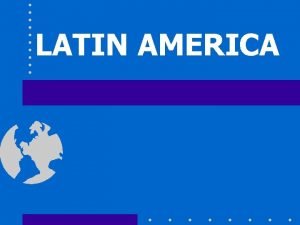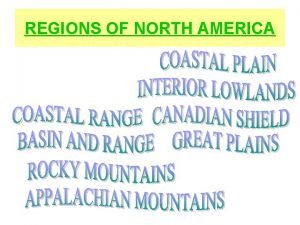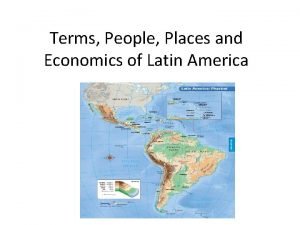Forecasting Fire Season Severity in South America Douglas




- Slides: 4

Forecasting Fire Season Severity in South America Douglas Morton & Jim Collatz, Code 618, NASA GSFC Yang Chen & Jim Randerson, UC-Irvine • Sea surface temperature anomalies enable forecasts of fire activity in South America 3 -5 months prior to the fire season. • Fires in forests and savannas responded similarly to climate variability. • Fire activity in Amazonia was highest in years with lowest deforestation, indicating a strong climatic control on active fires detections, burned area, and fire emissions in the region. Figure 1: Predicted and actual fire season severity in South America. High fire years occurred when both the tropical Pacific and Atlantic were anomalously warm. Figure 2: Predicted (red) versus actual (black) Fire Season Severity for 6 states in the Brazilian and Bolivian Amazon during 2001 -2011.

Name: Douglas Morton Code 618, NASA GSFC E-mail: douglas. morton@nasa. gov Phone: 301 -614 -6688 References: • Chen YC (UC-Irvine), Randerson JT (UC-Irvine), Morton DC (Code 618), De. Fries RS (Columbia), Collatz GJ (Code 618), Kasibhatla PS (Duke), Giglio L (UMD), Jin Y (UCIrvine), Marlier ME (Columbia). Forecasting Fire Season Severity in South America Using Sea Surface Temperature Anomalies. Science, 334: 787 -791, 11 November 2011. Data Sources: This study develops a predictive model of fire activity in South America based on sea surface temperature anomalies (Oceanic Niño Index-ONI, and Atlantic Multi-decadal Oscillation index-AMO) and active fires detected by the Terra/MODIS instrument (2000 -2009). The model was validated using active fire detections from Aqua/MODIS, TRMM-VIRS, and ATSR; burned area estimates for understory forest fires based on Terra/MODIS NDVI; and fire emissions from the Global Fire Emissions Database, version 3 (www. globalfiredata. org). The model was used to develop predictions for the 2010 and 2011 fire seasons in South America. Analyses also considered the relationships between sea surface temperature anomalies and TRMM precipitation estimates. Technical Description of Image: Figure 1: Fire season severity (FSS) anomalies for South America, calculated as the number of active fires per million hectares per year (#Mha-1 yr-1). The left panels show the actual (Terra/MODIS) and predicted FSS for low fire years (2001, 2008, and 2009), when sea surface temperature anomalies 3 -5 months prior to the fire season were strongly negative. The right panels show the spatial distribution of predicted and actual FSS for high fire years—years in which the tropical eastern Pacific and tropical north Atlantic were both anomalously warm. The predictive model captures much of the actual spatial pattern in the magnitude and distribution of FSS anomalies. Figure 2: Time series of predicted (red) and actual (black, Terra/MODIS) FSS for 6 states in the Brazilian and Bolivian Amazon during 2001 -2011. The predictive model explained more than half of the interannual variability in FSS in all 6 regions, including high fire activity in 2010. Predicted FSS for 2011 was normal or below normal for these Amazon regions. Scientific significance: We hypothesize that warmer sea surface temperatures displace the intertropical convergence zone (ITCZ), leading to a reduction in wet season precipitation across South America. Wet season precipitation may be an important regulator of drought intensity in the subsequent dry season. In high fire years such as 2005, 2007, and 2010, fires occurred earlier in the dry season, consistent with the impacts of reduced wet season precipitation. The importance of Pacific and Atlantic sea surface temperatures for precipitation and fire also varied regionally in South America. The eastern and northern Amazon responded strongly to variability in Pacific sea surface temperatures (ONI), whereas fires in the southern and western Amazon were more strongly correlated with sea surface temperatures in the tropical north Atlantic (AMO). The ability to characterize future fire risk using climate modes, as determined by sea surface temperatures, provides an alternate source of information on fire activity from projections of climate change. Relevance for future science and relationship to Decadal Survey: Our predictive model of fire season severity (FSS) has several direct applications. First, the strongest correlation between sea surface temperature anomalies and FSS occurs 3 -5 months prior to the fire season. Advance warning of the potential for a severe fire season may aid preparedness efforts in South America, including training and deploying fire fighting units and public education efforts to mitigate fire impacts on forest and savanna ecosystems, agricultural production, and public health. Second, our model of FSS provides an objective measure of potential fire activity from interannual variability in climate conditions. Ongoing efforts to Reduce Emissions from Deforestation and forest Degradation (REDD+) may benefit from this predictive tool, since the effectiveness of mitigation efforts can be compared to a predicted measure of fire season severity from climate alone. Finally, the long-term fire record from NASA’s satellites provides an important foundation for related science. With two MODIS instruments and the successful launch of NPP last month, we plan to continue our study of long-term patterns of fire activity, with a goal of identifying similar predictive relationships between climate modes and fire activity in other important biomass burning regions.

Evaluation of MODIS Snow Albedo Product (MDC 43) over Tundra Zhuosen Wang and Crystal Schaaf, BU Geography Miguel O. Román, Code 619, NASA GSFC • Global surface albedo is needed to quantify feedback strengths and impacts to the surface-atmosphere system, but more accurate predictions over snowcovered surfaces are required to improve model estimates of climate sensitivity. • This study demonstrates that MODIS albedo values are able to capture the rapid decline in surface albedo during the spring snow melt period. • The effects of spatial heterogeneity, coupled with highly anisotropic diffuse illumination and multiple scattering, should be considered for the calculation of snow albedo in polar regions. a. c. b. d. Figure 1: Locations of the Barrow and LTER/AON sites (TM and ETM +Bands 7 -4 -2) Figure 2: MCD 43 daily albedo (Unburned vs. Burned Tundra Sites) Figure 3: Full expression version of blue sky (SWIR) albedo at Barrow, 2007

References: Name: Miguel O. Román, NASA/GSFC E-mail: Miguel. O. Roman@nasa. gov Phone: 301 -614 -5498 Wang, Z. , C. B. Schaaf, M. J. Chopping, A. H. Strahler, J. Wang, M. O. Román, A. V. Rocha, C. E. Woodcock, Y. Shuai, Evaluation of Moderate-resolution Imaging Spectroradiometer (MODIS) snow albedo product (MCD 43 A) over tundra, Remote Sensing of Environment, doi: 10. 1016/j. rse. 2011. 10. 002, 2011 [in press]. Román, M. O. , C. B. Schaaf, P. Lewis, F. Gao, G. P. Anderson, J. L. Privette, A. H. Strahler, C. E. Woodcock, M. Barnsley, Assessing the coupling between surface albedo derived from MODIS and the fraction of diffuse skylight over spatially-characterized landscapes, Remote Sensing of Environment, 114, 738 -760, 2010. Román, M. O. , C. B. Schaaf, C. E. Woodcock, A. H. Strahler, X. Yang, R. H. Braswell, P. Curtis, K. J. Davis, D. Dragoni, M. L. Goulden, L. Gu, D. Y. Hollinger, T. E. Kolb, T. P. Meyer, J. W. Munger, J. L. Privette, A. D. Richardson, T. B. Wilson, S. C. Wofsy, The MODIS (Collection V 005) BRDF/albedo product: Assessment of spatial representativeness over forested landscapes, Remote Sensing of Environment, 113, 2476 -2498, 2009. Schaaf, C. B. , F. Gao, A. H. Strahler, W. Lucht, X. Li, T. Tsang, N. C. Strugnell, X. Zhang, Y. Jin, J. -P. Muller, P. Lewis, M. Barnsley, P. Hobson, M. Disney, G. Roberts, M. Dunderdale, C. Doll, R. d'Entremont, B. Hu, S. Liang, and J. L. Privette, and D. P. Roy, First Operational BRDF, Albedo and Nadir Reflectance Products from MODIS, Remote Sens. Environ. , 83, 135 -148, 2002. Data Sources: This is a joint effort composed of multiple centers including the Boston University’s Center for Remote Sensing (lead: MODIS BRDF/Albedo group), Montclair State University, Beijing Normal University, and the Marine Biological Laboratory (field sampling efforts), and NASA-GSFC’s Terrestrial Information Systems Laboratory (algorithm development and validation support). Technical Description of Images: (Figure 1) Top-of-Atmosphere (TOA) shortwave reflectance composites (TM and ETM +Bands 7 -4 -2) centered over the Barrow tower (a), unburned (b), moderately burned (c), and severely burned (d) sites after tundra fires on 08/17/2008. The circle stands for the tower footprint. (Figure 2) Comparison of MODIS BRDF/Albedo 1 -day daily full expression version of blue sky shortwave albedo between unburned and burned sites in 2007 shown as a function of solar zenith angle at local solar noon. (Figure 3) Comparison of temporal full expression blue sky shortwave albedo between ground albedo and MCD 43 1 -day daily, MCD 43 16 -day daily and MCD 43 standard albedo at Barrow in 2007. Here, the date of the MCD 43 standard albedo is renamed with the last day of the 16 days of input observations and the solar zenith angle of the last day is used to calculate the albedo. Snow cover is from MOD 10 A product. Scientific significance: The increased poleward retreat of the spring continental snow cover northern latitudes is consistent with an enhanced snowalbedo feedback (Déry & Brown, 2007). Snow albedo has also been linked to local enhancements in surface climate anomalies related to ENSO (El Nino– Southern Oscillation) (Yang, et al. , 2001), as well as variations in the Asian summer monsoon rainfall (Souma & Wang, 2010). Therefore, high quality global surface albedo is needed to further explore snow-albedo feedback strengths and impacts. This study demonstrates that MODIS albedo products perform well during the completely snow covered periods; particularly, when solar zenith angles do not exceed 70˚. Relevance for future science and relationship to Decadal Survey: Surface albedo is an essential climate variable (Schaaf et al. , 2008), and its accurate estimation across all surface types during all seasons is required for climate and biogeochemical modeling efforts. As production moves from MODIS data into NPP/JPSS VIIRS, user specifications require that production of global surface albedo also moves from the current multi-date approach to daily albedo computations. Hence, new retrieval strategies must be developed and examined to ensure that long-term systemic measurements are holding on throughout periods of rapidly changing conditions (e. g. snow-melt, inundation, burning, clearing, and tilling).







